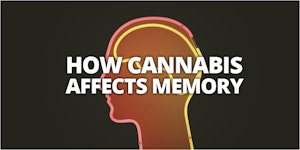This is what your brain looks like, on the inside, when consuming cannabis. The video below was written and created by our friends at AsapSCIENCE.
For centuries, humans have been using substances to alter their state of mind. From caffeine, cigarettes and alcohol, to more extreme drugs. But as the most commonly used illicit drug in North America, where does marijuana fit in? And how exactly does it affect your brain?
First, we need to understand how the brain functions. Your neurons are the cells that process information in the brain. By releasing chemicals called “neuro-transmitters” from the axon of one neuron to the dendrite of another they change the electrical charge of the receiving neuron, consequently exciting or inhibiting it.
If excited, the signal is passed on. Though it sounds simple, these signals work together and the effect is quickly compounded into complex configurations within milliseconds, flushing over the entire brain. This is what happens every single time you think, breath, or move.
So what is going on in your brain when you are smoking marijuana?
Well, unlike alcohol which contains molecules nothing like those in your body, cannabis contains molecules that resemble those produced in our very own brains – cannabinoids.
These cannabinoids circulate in much lower quantities compared to the large influx imposed by smoking. Specifically the chemical called Tetrahydrocannabinol, or THC, resembles a natural transmitter called Anandamide. These cannabinoids are specialized neurotransmitters released by neurons having just fired. Neurons temporarily become unresponsive after firing, to prevent them from overreacting or being too dominant. This allows your brain to function in a calm and controlled manner.
But cannabinoids interrupt this approach in some parts of the brain. Instead, they remove the refractory period of neurons that are already active and cause your thoughts, imagination and perception to utterly magnify itself. This means once you begin your train of thought, it becomes the most significant and profound thing ever.
You can’t see the big picture or even recall your last epiphany, because you are caught up in the momentum of a particular idea, and your neurons keep firing until a new idea takes hold, and you go off on a new tangent.
These cannabinoids also affect the levels of dopamine and norepinephrine in your brain. This often leads to a sense of euphoria, relaxation, pain modulation, and general enhancement of an experience, though sometimes causing anxiety. Furthermore, there are cannabinoid receptors in areas controlling short-term memory, learning, coordination, movement control and higher cognitive functions.
Got a burning question you want answered? Ask it in the comments below or on Facebook and Twitter.
Some sources:
1) Marijuana Myths Marijuana Facts: A Review of the Scientific Evidence
2) Physiological Review (Journal), vol. 83, 2003
3) Memoirs of an Addicted Brain – by Marc Lewis
4) The therapeutic potential of cannabis and cannabinoids.
5) Cannabis affects people differently
You may also like,
- How long does weed stay in your system?
- How long does weed stay in your urine?
- How to pass a drug test?
Herb Recommended Products:
READ MORE











